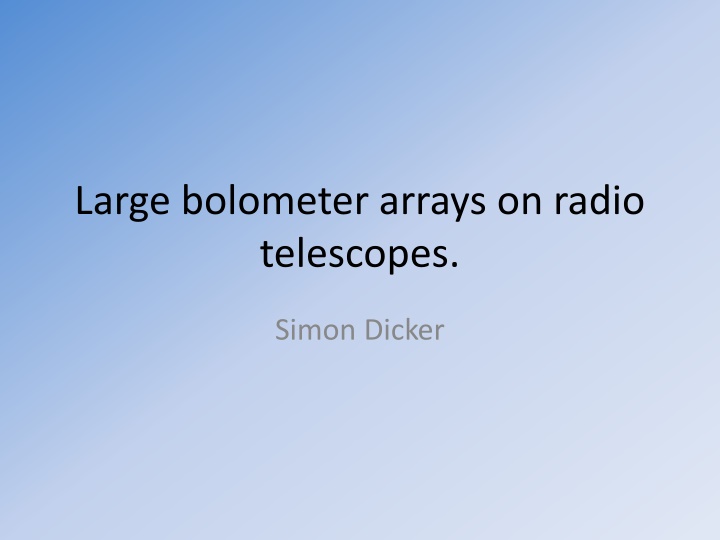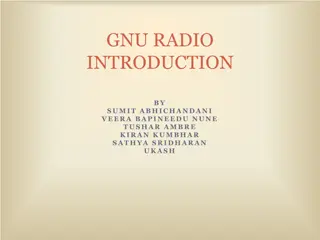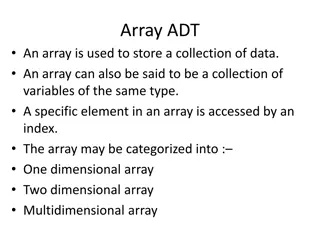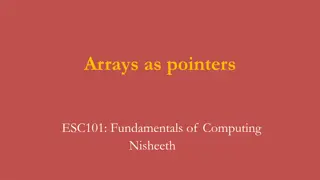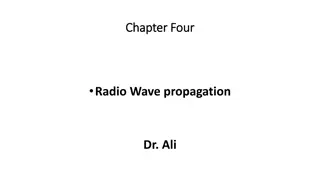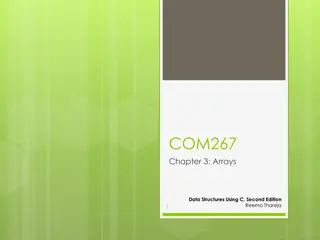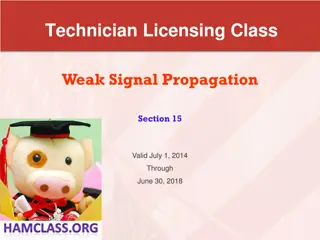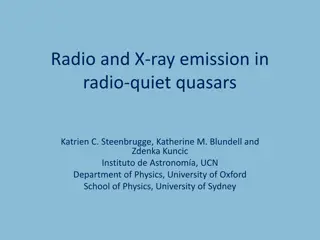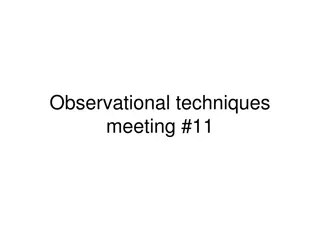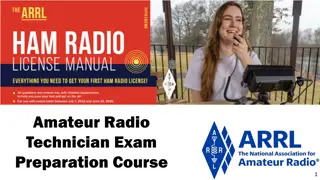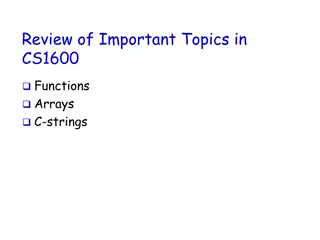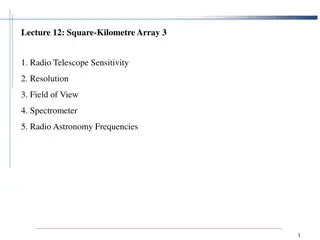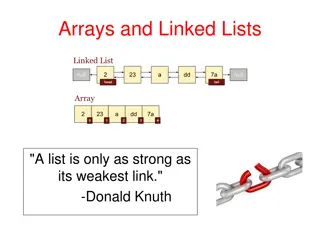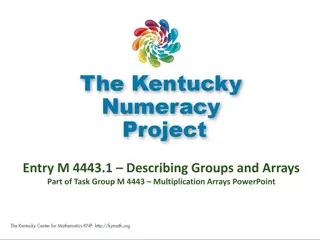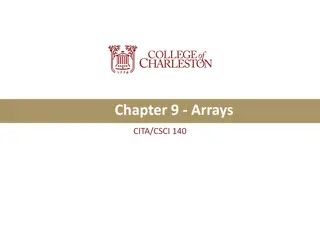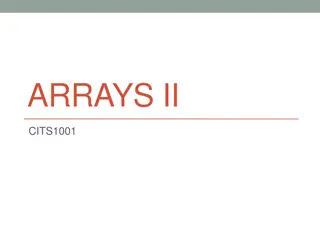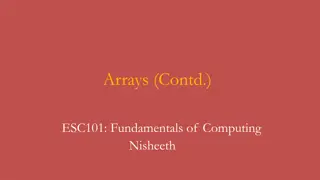Large Bolometer Arrays on Radio Telescopes: Simon Dicker
Large arrays on large telescopes can see details others cannot due to powerful field-of-views, removing atmospheric foregrounds at the expense of losing structure larger than the array. Bolometers operate by absorbing power and measuring temperature across all wavelengths with the need for filters to define bands. They use Transition Edge Sensors (TES), can be produced in large quantities, and have fast time constants. Bolometers, such as MUSTANG, differ in design and performance between MUSTANG and MUSTANG2, with the latter providing a more robust and adaptable design.
Download Presentation

Please find below an Image/Link to download the presentation.
The content on the website is provided AS IS for your information and personal use only. It may not be sold, licensed, or shared on other websites without obtaining consent from the author.If you encounter any issues during the download, it is possible that the publisher has removed the file from their server.
You are allowed to download the files provided on this website for personal or commercial use, subject to the condition that they are used lawfully. All files are the property of their respective owners.
The content on the website is provided AS IS for your information and personal use only. It may not be sold, licensed, or shared on other websites without obtaining consent from the author.
E N D
Presentation Transcript
Large bolometer arrays on radio telescopes. Simon Dicker
MUSTANG MUSTANG 64 absorber coupled TES bolometers 45 field of view Cold reimaging optics Bare pixels (0.7 f*lambda) Time Domain multiplexed readout 300mK cryogenics running off a PT405 On GBT 2006 Replaced by MUSTANG2
MUSTANG 2 AR coated UHMWPE window (large) 20 inches Filter Stack (a lot of optical power to block) Feedhorn array (300mK) 4.2 fov, f1.94 feeds. uMux readout Helium-4 sorption refrigerators (angled for better thermal stability with elevation requires turret rotator) Helium-3 sorption refrigerator (300mK) Future arrays may have to be colder PT 410 pulse tube from cryomech (1W cooling at 4.2K; 30W at 40K) Pushes limits of GBT compressors Installed on GBT 2014
Large arrays on large telescopes Large telescopes can see the details others cannot. Large field-of-views very powerful at removing atmospheric foregrounds. This comes at the expense of loosing structure larger than the array. Currently we do not make full use of the GBT s field of view. PLANK Beam (143 GHz) ACT beam (145GHz) MUSTANG 2 Beam Large arrays are easy to build with bolometers MUSTANG 1 fov MUSTANG 2 fov 0.85 Strehl limit at 90GHz With background limited detectors very high mapping speeds possible with 80,000 detectors => Few K /beam/second Real M2 timestreams simple common mode subtraction
Bolometers Simple operation absorb the power, measure the temperature Absorbs all wavelengths, need filters to define band Use Heat sinks from 4K to 100mK Originally used NTD thermometers Currently nearly all mm and submm bolometers use Transition Edge Sensors (TES) Can be made in large quantities Electrothermal feedback => fast time constants TES sensors = voltage biased superconductor Bi covered 1 m thick absorbing membrane 10 m thick legs TES sensor Silicon frame 3.3mm MUSTANG bolometers (original design)
Bolometers MUSTANG vs MUSTANG2 3.3mm 7 mm MUSTANG (similar to ACT) MUSTANG2 (similar to ACTpol) Large membranes => extra noise Susceptible to vibrations (V. high Q) Significant internal thermal barriers Easily damaged (95% yield) Half f*lambda spacing makes noise targets harder to meet Fits behind feedhorn. Planar OMT couples radiation to much smaller TES island via microstrip. Individual pixels allows us to pick and chose bolometers Much more robust design.
Bolometers latest. 150 GHz Ex 150 GHz Ey 90 GHz Ey 90 GHz Ex Photo Advanced ACT Photo SPT collaboration Same microstrip to small bolometer islands OMT or Planar antenna & lenslets Multiple bands/polarizations using microstrip filters. Deployments ACT / SPT : ~3000 Advanced ACT / SPT 3G : ~10 000 Simons Observatory : 80 000 CMB stage 4 : 250 000 bolometers Lots of work being done (by others) Heat pumps on bolometer legs. (can run off warmer baths) Hot electron bolometers Cost per detector/readout is dropping (less $1/pixel inc readout)
Multiplexing Readout 3 common Types: Time domain Frequency domain uMux Read out one row at a time at kHz rate. Num wires ~sqrt detectors 1 pair wires / row 1 pair wires /col Extra wires for detector bias ~1000 detectors /readout Feedback to keep SQUID amplifiers on sensitive part of their curves. Used by MUSTANG and ACT 2 by 2 mux layout
Multiplexing Readout 3 common Types: Time domain Frequency domain (SPT) uMux (NIST) Shunt resistor TES bolometers A 250 mK 4 K 300 K Each Bolometer bias has different filter in MHz range. Room temperature electronics generate tone for each resonator Currently 68 bolometers / 4 wires No Fundamental limit on number of detectors In practice stray capacitance/inductance limits number of detectors that can be multiplexed. Used by SPT/POLARBEAR Working on 128 bolometers for Simons Observatory
Multiplexing Readout 3 common Types: Time domain Frequency domain (SPT) uMux (NIST) MUSTANG2 style 32 resonator chip Each bolometer coupled to microwave resonator with a slightly different frequency. Measure phase changes using a comb of frequencies (4-8GHz) => readout with single pair of coax Also need flux ramp and detector bias wires (one per array). MUSTANG 2 : 64 channels/coax pair MUSTANG 2 w. new mux chips 256 channels/coax pair (512MHz bandwidth) Simons Observatory 2000 channels/coax pair New 1.8GHz spacing MUSTANG2 6GHz spacing
Bolometer design & cooling Ideal bolometer has noise dominated by atmosphere (easier at GBT than in space). (right) As band is divided up loading decreases. (bottom) Loading also decreases at lower frequencies and splitting polarizations. At some point you need a lower base temperature most CMB experiments have moved onto 100mK cryogenic systems. (bottom right) Can we get 100mK on the GBT? GBT Signal band 30GHz band, dual pol, Tc=450mK 2GHz band, single pol, Tc=450mK 2GHz band, single pol, Tc=200mK (software to produce the plots from Hannes Humbuyr - NIST)
Possible ideas K-band MUSTANG2 Replace the array, & filters. Rest of hardware stays the same. Can swap arrays for summer/winter. R=few spectrometer array Splitting the bands would give you a spectral index map as well as intensity with no noise penalty. Current backend could readout 1024 bolometers. Band variation could be an issue. Polarization Calibration angle could be tricky how well do we need to know this? Use the full field of view (~10 would require ~24 window) Would have to overflow the 24 turret slot
